



































PHOTOJOURNAL
October 31 - November 10, 2000
Day 180, Tues, Oct. 31, 2000 – Halloween in the
States, but we are a million miles away. We
had a relatively peaceful (although sweaty) snooze and the train pulled in an
hour earlier than expected at 4:30. As we staggered into the station we were met
with a vision from one of those cold-war era movies in which a nuclear disaster
or chemical plague
has decimated the population.  Half-dressed
bodies were strewn everywhere – men, women and children lying in various
positions, some on top of each other. We
snapped out of our overnight weariness and realized that the station was just
full of passengers
Half-dressed
bodies were strewn everywhere – men, women and children lying in various
positions, some on top of each other. We
snapped out of our overnight weariness and realized that the station was just
full of passengers waiting for trains and local homeless people who use the public area for a
relatively safe sleep. Naomi found
it literally impossible to make it to the toilet stalls through the crowd and
mess in the WC. We had arranged for
Upendra to meet us and drive us to Udaipur, but he was late.
After waiting with everyone else for a while, we realized there was a
special lounge for foreigners, which was spacious and empty.
Once Upendra showed up, we napped in his car through the countryside. He
was honking constantly to clear the road, but some animals didn’t quite get
the hint and we had some close calls. He
said accidents happy all the time – often enough that standard amounts have
been determined to reimburse
waiting for trains and local homeless people who use the public area for a
relatively safe sleep. Naomi found
it literally impossible to make it to the toilet stalls through the crowd and
mess in the WC. We had arranged for
Upendra to meet us and drive us to Udaipur, but he was late.
After waiting with everyone else for a while, we realized there was a
special lounge for foreigners, which was spacious and empty.
Once Upendra showed up, we napped in his car through the countryside. He
was honking constantly to clear the road, but some animals didn’t quite get
the hint and we had some close calls. He
said accidents happy all the time – often enough that standard amounts have
been determined to reimburse  farmers:
cows are 4,500, goats 2,000, and pigs 1,000.
Half way to Udaipur
farmers:
cows are 4,500, goats 2,000, and pigs 1,000.
Half way to Udaipur  we
stopped at the enormous 15th-century fort complex at Kumbhalgarh.
Its massive walls
extend 36 kilometers into the horizon, reminding us of the Great Wall of China.
The fort proved impregnable to all attacks except one in its history. We
walked up to the top of the fort, then along the walls with the local monkeys
before heading out.
we
stopped at the enormous 15th-century fort complex at Kumbhalgarh.
Its massive walls
extend 36 kilometers into the horizon, reminding us of the Great Wall of China.
The fort proved impregnable to all attacks except one in its history. We
walked up to the top of the fort, then along the walls with the local monkeys
before heading out.
Upendra stopped for some
betel nut, the seed that has a calming effect on chewers - something  like
tobacco. Unfortunately it has some
troublesome side effects, like turning teeth and gums black and leaving
tell-tale red splotches on the
like
tobacco. Unfortunately it has some
troublesome side effects, like turning teeth and gums black and leaving
tell-tale red splotches on the  (since all benefits of betel apparently reverse if you swallow).
We decided to pass in favor of Coca Cola, the "American betel".
On the way to Udaipur, we passed more colorful villages and Upendra
explained the many uses of the ubiquitous
Rajasthani turban – as a
blanket, a pillow, a towel, a sling, a tent, a hammock, or even a rope to pull someone from the
river. We also asked about two of
the most interesting aspects of Indian culture: arranged marriages and the caste
system in which everyone has their station in life predetermined based on the
circumstances of their (most recent) birth. The two issues are related since the marriages
which are arranged
(since all benefits of betel apparently reverse if you swallow).
We decided to pass in favor of Coca Cola, the "American betel".
On the way to Udaipur, we passed more colorful villages and Upendra
explained the many uses of the ubiquitous
Rajasthani turban – as a
blanket, a pillow, a towel, a sling, a tent, a hammock, or even a rope to pull someone from the
river. We also asked about two of
the most interesting aspects of Indian culture: arranged marriages and the caste
system in which everyone has their station in life predetermined based on the
circumstances of their (most recent) birth. The two issues are related since the marriages
which are arranged  must
follow the rigid caste system – marrying outside one’s caste is virtually
forbidden.
must
follow the rigid caste system – marrying outside one’s caste is virtually
forbidden.  The importance of family
and honor is tantamount.
The importance of family
and honor is tantamount.
One of
the most important negotiations is the dowry to accompany the woman in the
marriage. Dowries were outlawed
after independence, but it is one of the many old habits and traditions that are
impossible to eliminate. Once the
union of the two families is agreed, then a date is set.
Sometimes the happy couple never meet until the ceremony.
Because of all the planning and research made beforehand and the
investment of both families in the success of the union, divorce is very
uncommon and severe stigma is attached to divorcees.
Upendra is arranged to marry next year - luckily he has known his fiancé
for some time and finds her very suitable (we didn’t feel it appropriate to
ask about the dowry). We asked him
why Hindi movies often focus on young couples meeting and falling in love if the
society is against that method of match-making; he said that movies were just
for entertainment. The origins of
the caste system are murky, but it is generally believed to have come with the
invading Aryans from the north (yes, the same Aryans admired by the Nazis) who pushed local Dravidians south.
The Hindu sacred Vedas were written at this time (about 1500-1200
BC), formalizing the caste structure into the religion itself by codifying that
each caste was formed at the moment of creation.
Brahmins (priests and scholars) sprang from Brahma’s mouth, Kshatriyas
(soldiers and rulers)
sprang from his arms, Vaishyas (merchants and craftsmen) from his thighs, and
Shudras (serfs and peasants)
from his feet. These four castes are
further divided into dozens of sub castes or jati. A fifth class
of people are lowest of all, the Untouchables (now called Scheduled Castes or
Dalits). They are the street
sweepers and latrine cleaners of India and some Brahmins believe that the mere
shadow of a Dalit will make  them impure.
them impure.
 To many, these concepts are counter to
equality and fairness. Gandhi
fought for the rights of Dalits and they are now manipulated by politicians who
get votes by promising special programs and jobs.
By time
we arrived in Udaipur, we had talked Upendra’s ear off and he was probably
glad to be rid of us. The sun was
setting as we
checked into our room at Wonderview hotel overlooking the manmade lake.
The name was appropriate. From the bay window with cushy pillows we could see the whitewashed
buildings reflecting in the water.
To many, these concepts are counter to
equality and fairness. Gandhi
fought for the rights of Dalits and they are now manipulated by politicians who
get votes by promising special programs and jobs.
By time
we arrived in Udaipur, we had talked Upendra’s ear off and he was probably
glad to be rid of us. The sun was
setting as we
checked into our room at Wonderview hotel overlooking the manmade lake.
The name was appropriate. From the bay window with cushy pillows we could see the whitewashed
buildings reflecting in the water.
*******
Day 181, Wed, Nov 1, 2000 –
We slept in after the long journey yesterday, then took a short walk  around town doing admin. and
errands getting our first real look
around town doing admin. and
errands getting our first real look at the city. Udaipur was founded in
1568 when embattled Rajputs were still struggling against the growing Mughal
Empire. The man-made lake provides
the center of life and several islands with palaces, creating a “Venice of the
East”. The main attraction is the
City Palace on its banks, which we admired from our terrace from the opposite
bank over dinner.
at the city. Udaipur was founded in
1568 when embattled Rajputs were still struggling against the growing Mughal
Empire. The man-made lake provides
the center of life and several islands with palaces, creating a “Venice of the
East”. The main attraction is the
City Palace on its banks, which we admired from our terrace from the opposite
bank over dinner.
******
Day 182, Th., Nov 2, 2000
– Woke to the steady rhythm of laundry being pounded on the ghats
ghats  across
the lake. We walked across the lake
past workers harvesting weeds from the lake, shops, dogs, cows, several bullock
carts (which must be the only form of wheeled transportation slower than
walking), and the
same one-eared donkey we saw yesterday. We
walked up the long steps of the Jagdish Temple. Two women were selling bright
fresh flowers for puja offerings, beggars lined the steps and a sadhu was camped
under an elephant statue. The
temple was busy feeding beggars and sadhus and requesting donations, which we
contributed.
across
the lake. We walked across the lake
past workers harvesting weeds from the lake, shops, dogs, cows, several bullock
carts (which must be the only form of wheeled transportation slower than
walking), and the
same one-eared donkey we saw yesterday. We
walked up the long steps of the Jagdish Temple. Two women were selling bright
fresh flowers for puja offerings, beggars lined the steps and a sadhu was camped
under an elephant statue. The
temple was busy feeding beggars and sadhus and requesting donations, which we
contributed.
We continued to the City
Palace where we found Das, a guide
recommended as a local institution by Lonely Planet.
He was very informative, pointing out interesting tidbits and telling us
the tragic
 story of the princess who killed herself in the palace rather than be
the
story of the princess who killed herself in the palace rather than be
the
 object of a war for her affection, thereby saving her people.
He also told us about the family feud between the brothers in the Maharaja
family that continues to this day – a legacy of the transition from feudal
princely states supported by Britain to democracy after independence.
Some of the properties the family was allowed/negotiated to keep are now
hotels (such as the castle we stayed in). We toured one of
the palace hotels where
we had a lovely tea break.
object of a war for her affection, thereby saving her people.
He also told us about the family feud between the brothers in the Maharaja
family that continues to this day – a legacy of the transition from feudal
princely states supported by Britain to democracy after independence.
Some of the properties the family was allowed/negotiated to keep are now
hotels (such as the castle we stayed in). We toured one of
the palace hotels where
we had a lovely tea break.
This was followed by a long boat tour around the lake, visiting the palaces made famous by the James Bond film, Octopussy. The film is now shown every week in some restaurants and hotels. Our short visit to the “white city” was finished and we took a taxi to the airport for the 40 minute flight to the “Pink City" – Jaipur. At the Hotel Madubhan we tried to connect to the internet, but technology just wasn’t smiling on us today.
********
Day 183, Fri, Nov. 3, 2000 – After a minor fiasco (by Indian standards), we moved out of the Madubhan and into Hotel Umaid Bhawan up the street. Jaipur was founded in 1727 by namesake Maharaja Jai Singh II when he abandoned the mighty fort at Amber for a more roomy, special palace location. The color of nearly every building in the old city created the famed “Pink City” reputation. The entire city was painted in 1876 in tribute to the visiting Prince of Wales – later King Edward VII (“not that there’s anything wrong with that”). It has been repainted so many times, it actually appears more peach or cantaloupe in places.
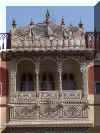 We took an auto rickshaw to the amazing City Palace from
the Maharaja ruled.
We took an auto rickshaw to the amazing City Palace from
the Maharaja ruled. 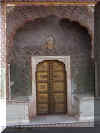 The colorful, mustached
guards still pose for photos for “tips” – probably the same
grizzled old-timers I posed with 10 years ago.
The palace has some wonderful marble, gold, elephant carriages and
ceremonial doorways with peacock motifs. The
biggest attraction (literally) in the costume museum is the coat of one royal
who was over two meters tall, 1.3 meters wide, and weighed 250 kg!
Locals were posing for photos in front of it, two or more at a time.
The colorful, mustached
guards still pose for photos for “tips” – probably the same
grizzled old-timers I posed with 10 years ago.
The palace has some wonderful marble, gold, elephant carriages and
ceremonial doorways with peacock motifs. The
biggest attraction (literally) in the costume museum is the coat of one royal
who was over two meters tall, 1.3 meters wide, and weighed 250 kg!
Locals were posing for photos in front of it, two or more at a time.
Outside the palace, we were enticed into a t-shirt shop with one of those ridiculous offers that can’t be true – “Please, madam, t-shirts for one dollar, please see my shop. No customers today”. We went inside just long enough to find out why they had no customers all day – because word must have gotten around that they were major rip-off artists. Naomi picked out one shirt and he tried to tell us it was $25. At first we thought he was joking, but we bust out laughing when he said “I am sorry, that is the price - there must be some misunderstanding”. We walked across the street and bought several shirts for $3 each, showing our bags to the jerks across the street – they just smiled and tilted their heads since they knew they were busted. We smiled as we told them we would tell all of our friends about them. The guys in the other shop were great – they chatted with us and let me try on a turban and Naomi a long pink sari. Although I thought she was lovely, she refused to allow a photo on this website. (note from Naomi: I already destroyed those shots.). The guys offered the following comments:
"For me the most important thing in my life is my wife."
"Money. Without money, no life, without money no wife"
"business – that I am successful – for my mother too."
The guys recommended a great stand-up lunch place, then we
had to go to the train station again to sort out tickets.
We had to stand in a special line for handicapped people, freedom
fighters, and foreigners. It was a nice grouping since we didn’t mind being
with freedom fighters and we certainly are handicapped because we are
foreigners. There must be a lot of
freedom fighters and veterans because the queue became typically  5 across as we
approached the window where everybody’s business is everybody else’s
business – including not only when and where you’re going, but why you’re
going, who you are meeting, why you are here at all, how much you are paying,
how much is in your wallet, and anything written on a paper in your hand.
Like everything to do with crowds in India, it’s a polite kind of
nosiness – a genuine curiosity and friendliness accompanied by smiles and an
occasional “please” and “thank you”.
The society has done a wonderful job of dealing with the coziness of
overpopulation, generating a reserved patience, acceptance and tolerance.
We couldn’t imagine the fistfights (not to mention the gunfights) that
would break out in the US in similar circumstances.
5 across as we
approached the window where everybody’s business is everybody else’s
business – including not only when and where you’re going, but why you’re
going, who you are meeting, why you are here at all, how much you are paying,
how much is in your wallet, and anything written on a paper in your hand.
Like everything to do with crowds in India, it’s a polite kind of
nosiness – a genuine curiosity and friendliness accompanied by smiles and an
occasional “please” and “thank you”.
The society has done a wonderful job of dealing with the coziness of
overpopulation, generating a reserved patience, acceptance and tolerance.
We couldn’t imagine the fistfights (not to mention the gunfights) that
would break out in the US in similar circumstances.
******
Day 184, Sat, Nov. 4, 2000 – We arranged for an auto rickshaw to take us out to the Amber Fort where we boarded an elephant for the long uphill walk to the fort. They were all painted with colorful ceremonial designs and were handled very well by the wallahs, who let us feed peanuts to their beasts, whose agile trunks sucked the snacks from our hands like giant vacuum cleaners – they were certainly more docile than the behemoths we saw in Africa. At the end of our ride (at the steepest part), we learned how they get that way when we saw our driver jam a metal spike into the soft spot behind the elephant's ear. It seems a bit harsh for the living embodiment of the beloved Hindu god of good fortune, Ganeesh, but I’m sure we’re missing something in the translation. We felt the same as we did on the donkeys in Petra – this is, after all, the birthplace of Buddha. At the top of the ramp, monkeys (who are somewhat more free) scrounge for food from tourists.
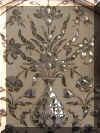 The fort itself is an
intriguing series of courtyards, including a mirrored pavilion and hall with
incredible cut glass and stone inlays. In
one room, an attendant closes the doors and strikes a match and the ceiling
twinkles like a glorious starry night – an illusion the royals enjoyed after
dinner and drink.
The fort itself is an
intriguing series of courtyards, including a mirrored pavilion and hall with
incredible cut glass and stone inlays. In
one room, an attendant closes the doors and strikes a match and the ceiling
twinkles like a glorious starry night – an illusion the royals enjoyed after
dinner and drink.
On the way back
into Jaipur, we stopped at the Lake Palace before our driver dropped us at  the
the
 Hama Mahal. This is the famous
“Palace of the Winds” where the ladies of the court used to sit and look out
at daily life from delicately honeycombed sandstone screens on dozens of tiny
balconies. Now there is just the facade which you can climb for a great view
over the palace and streets.
Hama Mahal. This is the famous
“Palace of the Winds” where the ladies of the court used to sit and look out
at daily life from delicately honeycombed sandstone screens on dozens of tiny
balconies. Now there is just the facade which you can climb for a great view
over the palace and streets.
Afterward, we had perhaps our best Indian meal at Handi restaurant, a huge bamboo and tin shack with Formica chairs that give no hint at the quality of the food. We had a feast of curries, barbecue and kebabs. It was deadly – we retired to our hotel and fell into long, deep food comas.
********
Day 185, Sun, Nov. 5, 2000 – At the train station waiting for our train to Agra, we watched an incredible spectacle. Like any train station, there’s never a lack of activity, but in India it has a character all its own. People don’t really rush and push as in the West, it’s more milling about and going about routines – old women hunched over short brooms, rag picking kids trying to earn a living from the filthy refuse dropped from the trains, vendors pushing carts and carrying bundles, men and women spitting (not always onto the tracks), porters balancing multiple bags on their heads while trotting around with the agility of Fred Astaire, families camped out in tight circles eating and chatting, businessmen reading the papers, beggars working the crowds, and kids pissing onto the tracks. We got a chance to see a lot because our train was delayed two hours – we had to ask around since the announcements were in Hindi. One man told us “they say it will be here after some time – don’t worry”. Apparently, precision in schedules or announcements is not to be expected, although most people took it in stride, as always. When we finally boarded the 7 hour train to Agra, we sat next to this wonderful older gentleman with sons in college in the US. We talked about family, religion politics – especially the upcoming US election. He was a bit concerned about Bush's international expertise (as we are) but said the republicans were more likely to befriend India in the never-ending rivalry with Pakistan. We told him about One World Foundation and he told us about his horrific experiences with ethnic strife when he was working as a doctor in Liberia during the civil war. In Agra we got a rickshaw to our reserved hotel, but they had given our room away. The manager showed us down the street to a “sister” hotel". We weren't too happy, but were too tired to argue. Outside the hotel, we saw our first Sadhu – a devout follower who has renounced all worldly things, including clothes. He stood stark naked, covered in gray ash, holding only his trident, a symbol of Shiva.
*******
Day 186, Mon, Nov. 6, 2000 – Our rickshaw driver
last night, Tudjua, so impressed us with his honesty (and book of
recommendations from tourists) that we agreed to hire him for a few days.
We started by sorting out buying plane tickets, etc, then headed out
for a trip 37 km outside town to Fatehpur Sikri.
Unfortunately, Tudjua’s rickshaw doesn't have the engine to make it
that far so he handed us off to his cousin, who had a brand new engine (although
it looked  pretty much the same). As
we drove through town, we witnessed Agra’s famed hazy smog, caused by decades
of industrial pollution. The World
Health Organization now
pretty much the same). As
we drove through town, we witnessed Agra’s famed hazy smog, caused by decades
of industrial pollution. The World
Health Organization now  categorizes
the city as a “pollution intensive zone”
with 5 times the maximum level of suspended particles the Taj can handle
without sustaining damage. It is
now closed and cleaned weekly and there is now a ban on new industries within
10,000 sq. km. and coke-burning industries have been told to move out.
As we left town and started through the less crowded countryside we
passed a few wretched brown bears in chains and muzzles dancing for tourists.
Unfortunately some tourists were stopping.
Our driver had to
categorizes
the city as a “pollution intensive zone”
with 5 times the maximum level of suspended particles the Taj can handle
without sustaining damage. It is
now closed and cleaned weekly and there is now a ban on new industries within
10,000 sq. km. and coke-burning industries have been told to move out.
As we left town and started through the less crowded countryside we
passed a few wretched brown bears in chains and muzzles dancing for tourists.
Unfortunately some tourists were stopping.
Our driver had to  make a few payments at police checkpoints since
rickshaws are not allowed on that route in order to protect the taxi trade.
He parked down
make a few payments at police checkpoints since
rickshaws are not allowed on that route in order to protect the taxi trade.
He parked down  the hill from the old city and we walked up the steep
stairs through the main gate. The
phantom city was deserted by the Mughal emperor Akbar in 1585 after serving only
15 years as his capital. Akbar is
one of the more famed rulers due to his intellectual curiosity, which brought
philosophers from all backgrounds to his Hall of Private Audience and Hall of
Public Audience for discourse and debate. Although
illiterate,
the hill from the old city and we walked up the steep
stairs through the main gate. The
phantom city was deserted by the Mughal emperor Akbar in 1585 after serving only
15 years as his capital. Akbar is
one of the more famed rulers due to his intellectual curiosity, which brought
philosophers from all backgrounds to his Hall of Private Audience and Hall of
Public Audience for discourse and debate. Although
illiterate, 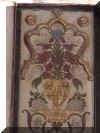 his self-styled education even lead to his development of a new
religion-attempting to meld them all together, although it never really caught
on.
his self-styled education even lead to his development of a new
religion-attempting to meld them all together, although it never really caught
on.
Akbar did not spare any
expense in building a city to honor the Muslim Saint that prophesied his first
son. Among the many other
structures are the courtyard where he dished out justice, complete with a ring
where elephants were tethered before being used as a tool for execution by
trampling; an elaborate treasury, a 5-story wind-tunnel palace with each floor
smaller than the one below, a giant Parcheesi board where he used teams of slave
girls as pieces and separate
palaces for his Muslim, Hindu, and Christian wives.
Victor Hugo was said to have commented that one of the palaces was
“either a very small palace or a very large jewelry box”.
It was great fun wandering this now-deserted ghost town imagining what
palace life was like back then. It’s
a little like the forbidden city in Beijing in that respect.
We went inside the tomb of the namesake mystic where thousands of
childless men and women
execution by
trampling; an elaborate treasury, a 5-story wind-tunnel palace with each floor
smaller than the one below, a giant Parcheesi board where he used teams of slave
girls as pieces and separate
palaces for his Muslim, Hindu, and Christian wives.
Victor Hugo was said to have commented that one of the palaces was
“either a very small palace or a very large jewelry box”.
It was great fun wandering this now-deserted ghost town imagining what
palace life was like back then. It’s
a little like the forbidden city in Beijing in that respect.
We went inside the tomb of the namesake mystic where thousands of
childless men and women visit every year to pray for children
visit every year to pray for children and leave colorful
strings tied to the marble screens. It
was a bit early for us to be tying a string but it was interesting to watch the
reverent faithful file in. On the
way back we watched shoeless kids playing cricket in the street, a reminder of
the national sport. It is currently
in a state of severe crisis as a match-fixing scandal has gripped the country. Nearly every newscast since we got here leads off with the
latest testimony, accusations and rumors. Apparently,
several top names are involved.
and leave colorful
strings tied to the marble screens. It
was a bit early for us to be tying a string but it was interesting to watch the
reverent faithful file in. On the
way back we watched shoeless kids playing cricket in the street, a reminder of
the national sport. It is currently
in a state of severe crisis as a match-fixing scandal has gripped the country. Nearly every newscast since we got here leads off with the
latest testimony, accusations and rumors. Apparently,
several top names are involved.
Back in town, Tudjua met us and dropped us at “a friend’s” restaurant where he gets commission. It was delicious.
********
Day 187, Tues, Nov. 7, 2000 – We were awake before
even the cows. We only saw one
(yawning) as we navigated the twisting lanes of Taj Ganj in the back of
Tudjua’s Rickshaw. Although he
knows these roads like the back of his hand, that doesn’t make them any more
comfortable – especially at 6 AM. As
we approached the Taj complex, hawkers and touts appeared from everywhere –
even at that hour. We arrived early
for sunrise as we had been advised, but there was a long line, as the ticket
window had not yet opened. When it did, there was ruckus in the ranks as some
had not yet heard of the recent (last week) change in foreigner tickets from
about $1 to $20. Some jerks
were crying bloody murder – “how dare they take advantage of us like
that!”, “we’re getting ripped off!”, “bloody thievery, innit?”,
“I’m writing to the f**king tourist board!”.
Some voices of reason could only counter “it’s only fair, they have a
valuable asset in a poor country…” before they were drowned out.
I held my tongue, smiling slightly since I knew what they hadn’t
learned yet - that the view of the Taj Mahal is worth far more than $20, and
this is what they would be telling their friends when they get back home. We got the tickets, walked down the front of the complex and
toward the main gate. The sandstone
and marble 
 gate is amazing itself, but as you round the corner you see the
outline of the Taj itself forming in the distance.
It stuns one to silence. As
Salman Rushdie wrote, “you cannot keep your emotions within bounds when that
soaring bubble of marble breaks upon your view”. It has been called “a tear on the face of eternity”,
“the most beautifully proportioned structure in the world”. The “monument to love” was built from 1631 to 1643 with
artists from Persia, France and Italy by Shah Jahan as a mausoleum to his beloved
wife, Mumtaz, who died giving birth to their 14th child. It was said that Shah Jahan's beard turned white overnight and
he mourned for years, writing “Empire has no sweetness. For me, now, life itself has lost all relish”.
Although the building was universally hailed as the most beautiful ever
designed, it bankrupted the kingdom and Shah Jahan was deposed by his son and
imprisoned for the last 8 years of his life.
Rumor has it that Shah Jahan had the hands of the master masons cut off
so they could never build a competing structure (wasn’t that what Ivan the
Terrible did to the builders of St. Basils in Moscow?).
From the time it was completed,
gate is amazing itself, but as you round the corner you see the
outline of the Taj itself forming in the distance.
It stuns one to silence. As
Salman Rushdie wrote, “you cannot keep your emotions within bounds when that
soaring bubble of marble breaks upon your view”. It has been called “a tear on the face of eternity”,
“the most beautifully proportioned structure in the world”. The “monument to love” was built from 1631 to 1643 with
artists from Persia, France and Italy by Shah Jahan as a mausoleum to his beloved
wife, Mumtaz, who died giving birth to their 14th child. It was said that Shah Jahan's beard turned white overnight and
he mourned for years, writing “Empire has no sweetness. For me, now, life itself has lost all relish”.
Although the building was universally hailed as the most beautiful ever
designed, it bankrupted the kingdom and Shah Jahan was deposed by his son and
imprisoned for the last 8 years of his life.
Rumor has it that Shah Jahan had the hands of the master masons cut off
so they could never build a competing structure (wasn’t that what Ivan the
Terrible did to the builders of St. Basils in Moscow?).
From the time it was completed, 
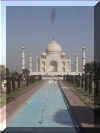 it has stood as a symbol of love and
devotion throughout the world for millions of romantics.
Although inconceivable to some, the plaque out front says that the
British Lord Bentinck considered dismantling the monument for scrap in 1833.
From the gate, a long reflecting pool leads
several meters to the glowing marble masterpiece. Like the Mona Lisa, it appears
smaller than you expect after all the buildup (the dome is only 81 feet high)
but its outline glows against the blue sky showing its incredible
symmetry and balance. It seems perfect - as though the slightest change in
design – one inch higher in the minarets or one inch lower in the dome would
have ruined it.
it has stood as a symbol of love and
devotion throughout the world for millions of romantics.
Although inconceivable to some, the plaque out front says that the
British Lord Bentinck considered dismantling the monument for scrap in 1833.
From the gate, a long reflecting pool leads
several meters to the glowing marble masterpiece. Like the Mona Lisa, it appears
smaller than you expect after all the buildup (the dome is only 81 feet high)
but its outline glows against the blue sky showing its incredible
symmetry and balance. It seems perfect - as though the slightest change in
design – one inch higher in the minarets or one inch lower in the dome would
have ruined it. 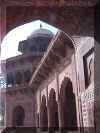
Yes, it is one of
those sights for which the word “sublime” may actually be used in all
seriousness and you may use the cliché “you really have to see it with your
own eyes”. Dozens of tourists
stood in awe as some jostled for the perfectly aligned photo of themselves in
the front. Of course as soon as
anything gets in the frame, the photo is ruined. As you can see, this holds true for photos of us as we posed
cheekily in front. As you approach,
the inlaid marble Arabic scripts and designs get clearer you notice the slight
tilt of the decorative minarets outward so they wouldn’t hit the
mausoleum if
they fell. The structure is
completely balanced from any angle, except for the tomb of Shah Jahan himself,
which sits to the side of his wife’s since the mausoleum was designed for
just hers. We
poked
around the two identical red sandstone mosque-type buildings on either side.
One is an operating mosque, but the other is merely for structural
balance. Inside, the tombs are
behind a screen, so we could not get a close-up view of the delicate
semi-precious stone inlays. Photos also are inadequate in the low interior
light.
minarets outward so they wouldn’t hit the
mausoleum if
they fell. The structure is
completely balanced from any angle, except for the tomb of Shah Jahan himself,
which sits to the side of his wife’s since the mausoleum was designed for
just hers. We
poked
around the two identical red sandstone mosque-type buildings on either side.
One is an operating mosque, but the other is merely for structural
balance. Inside, the tombs are
behind a screen, so we could not get a close-up view of the delicate
semi-precious stone inlays. Photos also are inadequate in the low interior
light.  As many as 43 different gems
were used for Mumtaz’s tomb. The
first time I was here the guide placed a flashlight on the edge of the tomb and we
could literally see the light penetrating the stone causing it to glow from
within. This is the real secret of
the Taj. The famous translucent
marble does change color
As many as 43 different gems
were used for Mumtaz’s tomb. The
first time I was here the guide placed a flashlight on the edge of the tomb and we
could literally see the light penetrating the stone causing it to glow from
within. This is the real secret of
the Taj. The famous translucent
marble does change color  and brightness throughout the day as the sun changes.
We stayed for about 4 hours, exploring every nook and cranny, and it
changed constantly. Sitting on the
steps, we met a practicing swami who was offering his services as teacher to
anyone who wanted. He was already
training a guy from Seattle that’s been following him all over India. He
said he was attending a religious conference in Agra and that the Dali Lama was
supposed to show up at the Taj Mahal today but cancelled at the last minute. The Dali Lama lives in Northern India after escaping over
the Himalayas with thousands of his countrymen after the Chinese invaded Tibet
over nearly a half century ago. He
now has a government in exile and the most organized refugee population in the
world, thanks to many supporters in the Western press and in Hollywood (like
Richard Gere and Steven Segal).
and brightness throughout the day as the sun changes.
We stayed for about 4 hours, exploring every nook and cranny, and it
changed constantly. Sitting on the
steps, we met a practicing swami who was offering his services as teacher to
anyone who wanted. He was already
training a guy from Seattle that’s been following him all over India. He
said he was attending a religious conference in Agra and that the Dali Lama was
supposed to show up at the Taj Mahal today but cancelled at the last minute. The Dali Lama lives in Northern India after escaping over
the Himalayas with thousands of his countrymen after the Chinese invaded Tibet
over nearly a half century ago. He
now has a government in exile and the most organized refugee population in the
world, thanks to many supporters in the Western press and in Hollywood (like
Richard Gere and Steven Segal).  Although
he must tread lightly with the Chinese to protect his followers.
Although
he must tread lightly with the Chinese to protect his followers.  He was awarded the 1989 Nobel Peace Prize for his outspoken championing
of peace by non-violent measures. Unfortunately,
his popularity has not yet won his people freedom from China’s annexation of
land and destruction of Tibetan culture (e.g. over 90% of Tibet's monasteries were
destroyed). Needless to say, we
would have been very happy (and lucky) to interview him today – a Buddhist monk at a
Muslim monument within a Hindu country. Fortunately,
he already answered our question in his Nobel acceptance speech:
He was awarded the 1989 Nobel Peace Prize for his outspoken championing
of peace by non-violent measures. Unfortunately,
his popularity has not yet won his people freedom from China’s annexation of
land and destruction of Tibetan culture (e.g. over 90% of Tibet's monasteries were
destroyed). Needless to say, we
would have been very happy (and lucky) to interview him today – a Buddhist monk at a
Muslim monument within a Hindu country. Fortunately,
he already answered our question in his Nobel acceptance speech:
“When I meet people in different parts of the world, I am always reminded that we are all basically alike: we are all
human beings. Maybe we have different clothes, our skin is a different
color, or we speak different languages. This is on the surface, but
basically we are the same human beings. That is what binds us to each
other - that is what makes it possible for us to understand each other and to
develop friendship and closeness.”
We reluctantly left after 4 hours to fight the crowd
outside and find Tudjua. He took us
on a winding, bumpy dirt-road tour 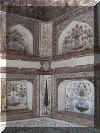 of Agra’s back alleys,
past the “Green
Agra, Clean Agra” billboards to a bridge across the Yumana River, which
scientists have recently declared incapable of supporting any life form.
As we passed over it seemed to support a fair number of naked kids
splashing around in it. Nowhere has a bridge supported more modes of transport at one
time – people, cars, buses, motos, trucks, vans, bicycles, rickshaws, horse
cart, and camel were all passed in the ten minutes it took to cross.
The only missing vehicle was an elephant.
The object of our journey was the mausoleum of Itimad-ud-Daulah, nicknamed
the “baby Taj”. It was built 15
years before the Taj Mahal on a much smaller scale, but it does not suffer much
in grace and design. The marble inlays were even more impressive in some
respects, with designs of flower vases, wine flasks and goblets.
of Agra’s back alleys,
past the “Green
Agra, Clean Agra” billboards to a bridge across the Yumana River, which
scientists have recently declared incapable of supporting any life form.
As we passed over it seemed to support a fair number of naked kids
splashing around in it. Nowhere has a bridge supported more modes of transport at one
time – people, cars, buses, motos, trucks, vans, bicycles, rickshaws, horse
cart, and camel were all passed in the ten minutes it took to cross.
The only missing vehicle was an elephant.
The object of our journey was the mausoleum of Itimad-ud-Daulah, nicknamed
the “baby Taj”. It was built 15
years before the Taj Mahal on a much smaller scale, but it does not suffer much
in grace and design. The marble inlays were even more impressive in some
respects, with designs of flower vases, wine flasks and goblets.
Afterward we had a nice outdoor lunch, disturbed only by the annoying
musician putting his obviously reluctant little boy to work dancing in front of
us. Tudjua agreed it was no good,
but allowed that it was sometimes necessary.
Since the fort was closed for a couple hours, we allowed Tudjua to take
us to his commission shops for marble, carpet, and jewelry.
He said he would get commission even if we didn’t buy anything.
Sadly, that’s a ploy to get us in the door – when you really don’t
buy anything you get a gruff goodbye and bad feelings all around.
One vendor of inlaid marble had some really incredible pieces, many of
which we’d love to have, but they were too expensive and heavy to send home.
He was quite insistent and disappointed. At
the jewelry shop, Naomi bought some silver bracelets and everyone was happy.
At the last place, Tudjua parked at the curb and I stepped right into the
open sewers we had been scrupulously avoiding for
weeks.
Tudjua and the shop owner leapt to action as they must have seen the look
on my face. They produced a stool
to sit on and a bucket of water to rinse my foot in.
It’s certainly not the most pleasant feeling I’ve known, but it
wasn’t life-threatening, so I felt like a dork being treated like an insulted
princess. The vendor felt so bad
(although it was my fault) that he
gave us a great price on a small marble tile inlaid with a design from the Taj
Mahal. We were happy to have a
reminder of one of the most beautiful things we have seen.
Our first view inside the fort was two monkeys practicing their procreative abilities over the gate. The red sandstone complex which resembles the Delhi Fort dominates the side of the Yamuna river with 70 foot high walls in a 3 km circle. It was built in 1565 by Akbar before his stint at Fatepur Sikri. The moat is now squalid, but the interior is remarkable, with pleasure palaces added by later rulers. In the courtyard, Jahinger received Captain William Hawkins, the first envoy from England, in 1609 - his marble throne was cracked by a British cannonball 248 years later. The open-air pavilions have some amazing inlay work, rivaling that of the Taj. We also got a look at the prisoners tower which housed Shah Jahan in his last days, gazing wistfully across the river to his beloved Mumtaz Mahal.
Afterward, Tudjua took us to the hotel of another “friend” in Taj
Ganj, the city that developed to house the thousands of Taj construction workers
(it is now
 the tourist ghetto). We
had a drink on the roof with a young Japanese girl traveling through India on
her own. We thought she was very brave, especially coming from such a
protective society – apparently the younger generation is less insular.
We watched the sun set on the Taj a few hundred meters away.
It changed colors another 12 times, but unfortunately did not get that
red tint you see in postcards because it was too hazy in the west of town.
the tourist ghetto). We
had a drink on the roof with a young Japanese girl traveling through India on
her own. We thought she was very brave, especially coming from such a
protective society – apparently the younger generation is less insular.
We watched the sun set on the Taj a few hundred meters away.
It changed colors another 12 times, but unfortunately did not get that
red tint you see in postcards because it was too hazy in the west of town.
*******
Day 188, Wed, Nov. 8, 2000 – We woke early to
watch the US election results. We
heard them announce Florida for Gore, which was a big surprise since Bush’s
brother runs the state as governor. By
the time we were ready to leave, they had changed their mind and given it to
Bush. We had an argument with the
hotel manager over the terrible service provided during our stay (including
being lied to repeatedly and people walking into our room without knocking).
By the time we got to the airport, the election was all down to Florida.
We went through a triple security check – which is odd for domestic
flights – and boarded the 40-minute flight to Khajuraho.
We got a ride directly to the Holiday Inn, which actually understands
service. We decided to stay in a
nice hotel not only because of our experience in Agra, but also to watch BBC on
satellite since the election was getting pretty wild. Talking heads, anchors and spin doctors beat it to death
all day. We had room service lunch
and dinner nearby.
*******
Day 189, Thur, Nov. 9, 2000 – Another day of spin
as the national vote is almost 48 to 48 and Bush is barely ahead in Florida.
The most amazing part is the ridiculous decades-old punch-card system
still in use in the computer age. Thousands of ballots were rejected for various
reasons and some people were so confused by the ballot design that some 20,000 accidentally
voted for Hitler admirer Pat Buchanan of all people.
Of course Bush wants all counting stopped, but Gore wants recounts and
investigation of the alleged irregularities.
We all know they would swap arguments if the vote was going the other
way. Now, as so often happens in
the US, the millionaire lawyers have been called in to fight it out in court.
This is going to be ugly.
We hired our taxi driver from yesterday to take us around
the temples for the day. Khajuraho’s
claim to fame is the unique abundance of 1,000-year old erotic temple sculpture.
The temples were constructed by the powerful Rajput Chandela dynasties of
the 10th – 12th centuries.
 The Chandelas lived in a time of abundance and lived life to the fullest,
creating the most energetic, sensuous, and memorable temple art in the Hindu
regions. The dynasty would end with
Muslim conquerors attacking the “infidels” and “idolaters”.
Due to its remote location, Khajuraho would be forgotten for hundreds
of years, discovered by the British in 1838 buried under centuries of monsoon
sand, mud and jungle growth. We can
only imagine the looks on the faces of Victorian-era colonials when they
stumbled upon some of the unashamedly sensual images.
The Chandelas lived in a time of abundance and lived life to the fullest,
creating the most energetic, sensuous, and memorable temple art in the Hindu
regions. The dynasty would end with
Muslim conquerors attacking the “infidels” and “idolaters”.
Due to its remote location, Khajuraho would be forgotten for hundreds
of years, discovered by the British in 1838 buried under centuries of monsoon
sand, mud and jungle growth. We can
only imagine the looks on the faces of Victorian-era colonials when they
stumbled upon some of the unashamedly sensual images.
Of the 85 original temples, only 22 remain.
Thankfully, they are well-preserved and some sculptures look like they
could have been done this century. Our
driver took us to all of them – he was a great guy – from this area –
happy to see tourists come, but sad that they usually only stay one night.
We started at the Western Group, 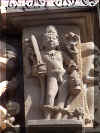 which
contains the most famous temples – the ones containing the kinky postcard
images seen all over India. We got
the portable cassette tour, which was a great buy.
From a distance, the temples look like any other, steps leading to a
porch, inner hall, and a
central spire rising toward the heavens. On
closer inspection, the figures on the walls materialize into virile men and
voluptuous women. It is amazing
that the past 10 centuries have not destroyed the delicate features like noses,
eyes, mustaches and fingers. Some
figures are in rigid poses, but some are in sinuous, twisting forms - some
playful and relaxed going about normal routines like hunting, battling, dancing
and playing music, and some are downright acrobatic in elaborate sexual embraces
that would usually be found only in 20th century porn films. Although the poses leave little to the imagination, the
initial temptation to joke eventually gives way to admiration of the artwork,
skill and sense of humor involved in their creation.
Each panel tells a little story of romance, intrigue and innuendo with
the heavy symbolism of real and mythological animals like men with heads of
horses, lions and boars. The women
- apsaras (heavenly maidens), dancing girls and nymphs are shown
which
contains the most famous temples – the ones containing the kinky postcard
images seen all over India. We got
the portable cassette tour, which was a great buy.
From a distance, the temples look like any other, steps leading to a
porch, inner hall, and a
central spire rising toward the heavens. On
closer inspection, the figures on the walls materialize into virile men and
voluptuous women. It is amazing
that the past 10 centuries have not destroyed the delicate features like noses,
eyes, mustaches and fingers. Some
figures are in rigid poses, but some are in sinuous, twisting forms - some
playful and relaxed going about normal routines like hunting, battling, dancing
and playing music, and some are downright acrobatic in elaborate sexual embraces
that would usually be found only in 20th century porn films. Although the poses leave little to the imagination, the
initial temptation to joke eventually gives way to admiration of the artwork,
skill and sense of humor involved in their creation.
Each panel tells a little story of romance, intrigue and innuendo with
the heavy symbolism of real and mythological animals like men with heads of
horses, lions and boars. The women
- apsaras (heavenly maidens), dancing girls and nymphs are shown 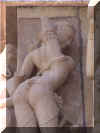 coyly yawning, stretching, pouting, posing, looking in mirrors, playing with
babies and monkeys, applying makeup, and lounging seductively. Most of the women have clinging saris or dresses as if soaked
to the skin and enormous exaggerated cleavage that would make Pamela Anderson
green
coyly yawning, stretching, pouting, posing, looking in mirrors, playing with
babies and monkeys, applying makeup, and lounging seductively. Most of the women have clinging saris or dresses as if soaked
to the skin and enormous exaggerated cleavage that would make Pamela Anderson
green with envy. They were the very
picture of grace and femininity - Rodin by way of Hugh Hefner.
Their lovers are noticeably appreciative of them and good times are had
by all, except for a few men who appear to be jealously looking on from the
sides. The overall effect is a
celebration of sensuality in stone – it is a bit odd to follow the sublime
experience of the Taj Mahal, where all is balance, serenity and ethereal beauty
with the bawdy in-your-face earthy sensuality of Khajuraho.
As such, some find it difficult to admire the religious aspects of the
structures. There are many theories
as to why sex is so important here – the locals don’t know for sure. One of the more plausible is that the Chandelas were of the
tantric branch of Hinduism, dedicated to experiencing all of physical life
rather than removing themselves to contemplate on the illusion of it all.
Another is that it is the ultimate tribute to the god of creation, as
procreation should be cause
with envy. They were the very
picture of grace and femininity - Rodin by way of Hugh Hefner.
Their lovers are noticeably appreciative of them and good times are had
by all, except for a few men who appear to be jealously looking on from the
sides. The overall effect is a
celebration of sensuality in stone – it is a bit odd to follow the sublime
experience of the Taj Mahal, where all is balance, serenity and ethereal beauty
with the bawdy in-your-face earthy sensuality of Khajuraho.
As such, some find it difficult to admire the religious aspects of the
structures. There are many theories
as to why sex is so important here – the locals don’t know for sure. One of the more plausible is that the Chandelas were of the
tantric branch of Hinduism, dedicated to experiencing all of physical life
rather than removing themselves to contemplate on the illusion of it all.
Another is that it is the ultimate tribute to the god of creation, as
procreation should be cause 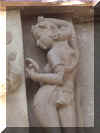 for
fun and rejoicing. Local folklore
says the images were too bawdy for the goddess of lightening to look at, so she
never struck the temples. Another
theory is that the images get less kinky as you progress up the temple, showing
how sex is initially animalistic (indeed there is a rather curious scene with a
horse) but grows into
for
fun and rejoicing. Local folklore
says the images were too bawdy for the goddess of lightening to look at, so she
never struck the temples. Another
theory is that the images get less kinky as you progress up the temple, showing
how sex is initially animalistic (indeed there is a rather curious scene with a
horse) but grows into 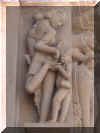 a
loving union as the gods intended. Some
point out that the amorous couples are on the outside while the inside is for
the gods (although there are exceptions). Historians
have also claimed that the founder of the Chandela dynasty was born of an
illicit union so when he gained power his mother begged him to build temples
showing the natural divinity of lovemaking.
Then again, perhaps it is just an elaborate Kama Sutra in
stone, a pictorial representation of what had been written long before so people
could see what was explained. Whatever
the reason for their construction, they now stand as examples of artistic skill
that turn each visitor's prurient curiosity into smiles of appreciation.
Okay, maybe we did snicker a couple times as we realized that it is not
just modern western television and movies that have a preoccupation with
sex. Although we include only
the tamer, non-gymnastic images below, you may want to skip ahead if you
are somewhat of a prude.
a
loving union as the gods intended. Some
point out that the amorous couples are on the outside while the inside is for
the gods (although there are exceptions). Historians
have also claimed that the founder of the Chandela dynasty was born of an
illicit union so when he gained power his mother begged him to build temples
showing the natural divinity of lovemaking.
Then again, perhaps it is just an elaborate Kama Sutra in
stone, a pictorial representation of what had been written long before so people
could see what was explained. Whatever
the reason for their construction, they now stand as examples of artistic skill
that turn each visitor's prurient curiosity into smiles of appreciation.
Okay, maybe we did snicker a couple times as we realized that it is not
just modern western television and movies that have a preoccupation with
sex. Although we include only
the tamer, non-gymnastic images below, you may want to skip ahead if you
are somewhat of a prude.
After the long trip, we had an excellent relaxing Italian
dinner at the rooftop restaurant Mediterraneo instead and watched more agonizing election
coverage. The disingenuous lackey
spokesmen are really hard to stomach, but we can’t stop watching them.
******
Day 190, Fri, Nov. 10, 2000 – Woke to more BBC, a
great breakfast buffet and more writing. In
the afternoon we took a bicycle rickshaw for a ride into town, hiring the most
desperate looking old guy outside the hotel. The ride was the exact opposite of a ride in Delhi.
It was peaceful, quiet and relaxing instead of chaotic, noisy and
stressful. The sun set over a
small lake in town as we watched from the balcony of the Paradise restaurant.
The food was great and the owner and his son spoke to us.
The son, Manosh, said his name is the same as the god of love.
 "Be
happy for the life – that’s the first thing.
Family is very important. All
the time they support us, so we support the family.
It is also nice to go traveling somewhere; it’s a very good experience
in life. Everybody has to go and
get experience. It lets you meet
all kinds of people. Then I feel
very good because I can learn about other people of earth.
When I talk to them, I get something from them, and they get something
from us. We can change our thoughts
and we can go deeply about his earth so maybe we can choose a way of life better"
"Be
happy for the life – that’s the first thing.
Family is very important. All
the time they support us, so we support the family.
It is also nice to go traveling somewhere; it’s a very good experience
in life. Everybody has to go and
get experience. It lets you meet
all kinds of people. Then I feel
very good because I can learn about other people of earth.
When I talk to them, I get something from them, and they get something
from us. We can change our thoughts
and we can go deeply about his earth so maybe we can choose a way of life better"
*******
If you would like to follow our adventure to Varanasi, please click here: Photojournal November 11 -16.
If you have any comments, suggestions, or other feedback, please see our contact information and send us a note.
Thanks for your support!























































